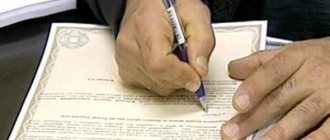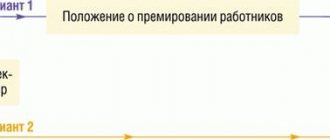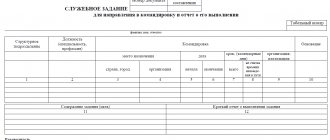Why and when are they given the right to sign papers?
Documents are endorsed not only by the manager, but also by other employees - within the limits of their functionality.
Accountants endorse balance sheets, accounts and reconciliation reports, economists – plans, reports and calculations, lawyers – contracts, specifications and claims, personnel officers – personnel orders, work books and memos. Who and what exactly is authorized to endorse is included in the sample order granting the right to sign or power of attorney. The right of first and second signature is distinguished. The first belongs to the leader. To grant such a right, a sample order on the right of first signature is used. The second is provided to an authorized representative - an employee of a budget organization. Such information is reflected in:
- order;
- job description;
- position;
- powers of attorney.
The first three relate to internal documentation. It is unacceptable to register them in the name of a person who is not in an employment relationship with the organization. But a power of attorney can be issued both to a regular person and to a third party.
How to place an order
The approach to drawing up orders can also be absolutely anything: companies have the right to use simple A4 or A5 sheets or their own letterhead to write these administrative documents. In this case, the order can be written by hand or printed on a computer - this does not play any role in determining the legality of the document.
However, with all this, the order must be certified by the signature of the head of the enterprise or any other employee authorized to endorse such papers.
In addition, everyone who is mentioned in it, as well as the employees appointed responsible for its execution, must be familiarized with the document for signature. Whether to put a seal on the order or not is the choice of the drafter, since it relates to the internal document flow of the company; moreover, since 2020, the requirement for the mandatory use of seals and stamps in the activities of legal entities has been abolished by law.
The order is usually drawn up in a single original copy.
The right to sign primary documents: order or power of attorney
Any option is suitable, but it is necessary to specify which documents the employee can endorse. It happens that the accounting department issues a power of attorney to sign a delivery note one-time - to receive a specific batch of goods or products. Usually we are talking about granting powers to a person who performs such tasks occasionally.
The director must approve the list of persons authorized to sign primary documents by order.
IMPORTANT!
Responsibility for the execution of a business transaction and the accuracy of the data lies with the person who endorsed the primary document, and not with the person who keeps the accounting records.
Terms of office also differ. Thus, a power of attorney is limited to the period specified in it. Local acts are valid until the employment relationship with the employee is terminated or until it is canceled or a new version is adopted. You can specify the duration of powers in the document itself, for example, set a one-year period. Often powers are assigned for the period of absence of an employee; the period in this case is determined by the period of replacement.
What to write in the order
Formulations are at the discretion of the administration. Typically, a sample order for the right to sign documents contains general phrases, and a power of attorney details the rights. If we are talking about the endorsement of contracts, representation of the interests of a budgetary organization in third-party institutions, government bodies, then it is advisable to issue a power of attorney. Counterparties always insist on confirmation of the representative’s authority, requiring a power of attorney.
When approving personnel documents, no reference is made to the details, but when approving contracts, on the contrary, the date and number of the authorizing act are indicated.
Signature by proxy
A power of attorney is a written document that delegates certain powers. In our case, this is the transfer of the right to sign. Such a power of attorney for the right to sign can only be issued by a person who has this right unconditionally according to the constituent data, that is, most often, a representative of the management.
The format of the power of attorney and the format of the document being signed must match. For example, if a transaction that requires notarization is signed under a power of attorney, then the power of attorney must also be notarized.
If you strictly follow the rules, then the document must contain an indication of the signatory’s right to act on behalf of the organization: a signature based on the constituent documents, an order or instruction from management, a power of attorney.
NOTE! If a power of attorney is issued on behalf of a legal entity, then it must be issued by the director or another person specified in the constituent documents.
Sample order on the right to sign primary documents
Agreement, invoice, delivery note, invoice are the most common official documents of primary accounting. The list is open: the administration can expand it by establishing other forms in the accounting policy.
The primary document first of all confirms the fact of a business transaction. And it also serves as the basis for recording transactions in accounts. Issued upon completion of the fact or after the completion of the transaction.
What are primary documents
Papers are primary if they register completed business transactions. It turns out that in order to enter facts and information into accounting, primary documentation in the form of contracts and executed transactions is required.
Any act of the primary type carries information about the economic activities of the enterprise, as well as economic facts.
Primary documents: types
Important! The papers must be kept for 4 years, since during this time the tax authority can check the availability of such data.
Basic information
Any business-type operation carried out at an enterprise or organization is accompanied by the execution of special documents, which are called primary documents.
Accounting is maintained based on the totality of documentation.
Important! Any document must be signed by a responsible person who has this responsibility.
The possibility of signature can be established by a special order, accounting policy or additional papers, which include job descriptions and powers of attorney.
According to the law, it is desirable to have a list of persons in the accounting documentation. This will avoid problems with filling out forms.
What is a signature
A signature means the signature of a representative or official. It must be handwritten and confirms the authenticity of the act or copy.
The signature consists of three main parts, including the job title, personal signature and decoding, which includes the surname and initials.
Important! If organization letterheads are used, the name of the organization is not required. Otherwise, it is necessary, for example, if the document is drawn up on a blank sheet of paper.
The signing itself means the presence of legal force, so only the person identified through various documentation should sign.
Read also: Software for accounting
What belongs to this category
This category includes an accounting document for accountants and tax authorities. Documentation:
- invoice;
- payment order;
- Act;
- discharge;
- reference;
- invoice.
This also includes all papers that are related to the economic activities of the organization. They must be properly designed and also contain the signatures of the responsible persons.
Primary documents
Legal basis
The base includes several basic regulations. Among them:
- Order of the Ministry of Finance of the Russian Federation dated July 29, 1998 No. 34n, approving the provisions for maintaining accounting and accounting-type reporting;
- Federal Law No. 402-FZ, regulating accounting;
- Federal Law No. 129, Article 9 of November 21, 1996.
According to the latest legislative act, any process of drawing up a primary act requires the availability of details.
According to the law, correct preparation of documentation is mandatory, since records are kept on the basis of it.
Why is a primary needed?
The primary record is used to record the actions of the entrepreneur and the organization, that is, any activity is accountable.
Documentation can be unified or arbitrary. It all depends on the type of activity and the presence of additional factors, for example, there is a hazardous production or the company is engaged in government supplies. Any paper contains a number of data:
- name and date of compilation;
- Business name;
- type and name of business operation;
- data of persons involved in the operation;
- the signature of the responsible person, that is, the one who has the right to carry out this operation and the execution of the form.
Painting is considered mandatory. At the same time, it doesn’t matter whether it is digital or handwritten. The main thing will be the presence of a painting and the possibility of a face on it.
Sample order for the right to sign financial documents
Financial papers show solvency and profitability. In this sense, the balance is informative. It reflects the financial position at the end of the period. By looking at the balance sheet, a specialist can easily determine whether the counterparty has sources of funds, property, or only debts and obligations. Other financial papers: consolidated income statement, statement of funds and their use.
Loans and credit agreements can also be classified as financial securities.
Sample order on the right to sign invoices
An invoice is proof of the completed shipment of goods or provision of services. The cost is also indicated. Registration is regulated by Article 169 of the Tax Code of the Russian Federation, which allows the following options for signing a paper version:
- manager and chief accountant;
- leader;
- by another person by order;
- person by proxy.
The electronic version is endorsed with an enhanced qualified electronic signature.
Sample order for the right to sign the chief accountant
Previously, monetary and settlement documents not signed by the chief accountant were considered invalid and were not accepted for execution. With the adoption of the Federal Law “On Accounting” No. 402, the situation changed. According to Art. 73, accounting must be entrusted by the head to the chief accountant. Alternative options include another employee and a third-party accountant. It is allowed for the manager to conduct accounting personally, unless we are talking about a credit organization.
How to revoke signature rights
A previously issued act is canceled by issuing a new one - a repealing one. It must indicate:
- which act is being repealed;
- from what date;
- column for reference.
Informing the authorized person about the cancellation is mandatory. Such a person can sign both on the order itself and on a separate familiarization sheet.
A power of attorney executed on the organization's letterhead is canceled by an administrative document of the head. Notarized - by a notary. The provision of information is mandatory, as in the case of cancellation.
How is the “signature” requisite completed?
It would seem that what could be simpler - to put your signature? Meanwhile, this is as serious a requisite as the name of the organization and its banking attributes. Therefore, the correctness of its execution must coincide with the requirements for office work.
Signature elements
The signature as a prop consists of three parts.
- The title of the position must be indicated in full in accordance with the staffing table. If the signature is not on official letterhead, then the name of the organization must be added to the title of the position. It is written with a capital letter. This element is located on the left edge of the document.
- A personal signature is what is commonly called a painting. There are no special requirements for it: it can be either a stroke or a surname with one or more initials. According to unspoken rules, at least one letter from the first name and three from the surname must be clear from the stroke.
- Deciphering the signature – initials and surname. It must completely match the passport data, down to the dots in the letter e, if they are present on the identity card. Placed at the level of the last line of the signature.
Signature location
The signature is inseparable from the text of the document. If the text ends at the bottom of the page, then the signature cannot be transferred to a separate sheet if there is no other text on the sheet besides it. It is customary to move at least the last paragraph, but do not forget about the correct page numbering.
If several signatures are provided, then they are located one below the other in descending order of the nomenclature importance of the positions.
FOR YOUR INFORMATION! If members of the commission sign, then it is necessary to indicate not their actual positions, but their role in the commission (“Chairman”, “Member of the commission”). But they need to be arranged in order of subordination.
IOF or Full Name?
The order of placement of initials - before or after the surname - is determined by Decree of the State Standard of the Russian Federation dated 03.03.2003 N 65-st and the Unified System of Organizational and Administrative Documentation “Requirements for the preparation of documents. GOST R 6.30-2003".
According to these regulations, initials are placed after the surname in the following cases:
- when addressing a document to an individual (for example, A.P. Koroleva);
- when declaring or imposing a resolution when specifying the executor (for example, “The order is entrusted to I.I. Romanov”).
If the signature is a requisite, then the initials are placed before the surname . There is a dot after the initials; they are not separated from the surname by a space.
Stamp on signature
The use of a seal is not mandatory for some forms of business activity, for example, for individual entrepreneurs. But for most documents, the presence of a seal will certify their authenticity. Its use is subject to mandatory requirements that must be observed.
- A seal cannot be placed before a signature, especially on a blank sheet of paper.
- If the document is drawn up on a special form, then the seal is placed in the place provided for this purpose, imprinted with the letters M.P. (“place of printing”).
- In other cases, the seal is placed next to the signature; it is allowed (but not required) to overlap part of the personal signature with the edge of the seal. The stroke cannot be completely covered up, since its authenticity must be verifiable.










